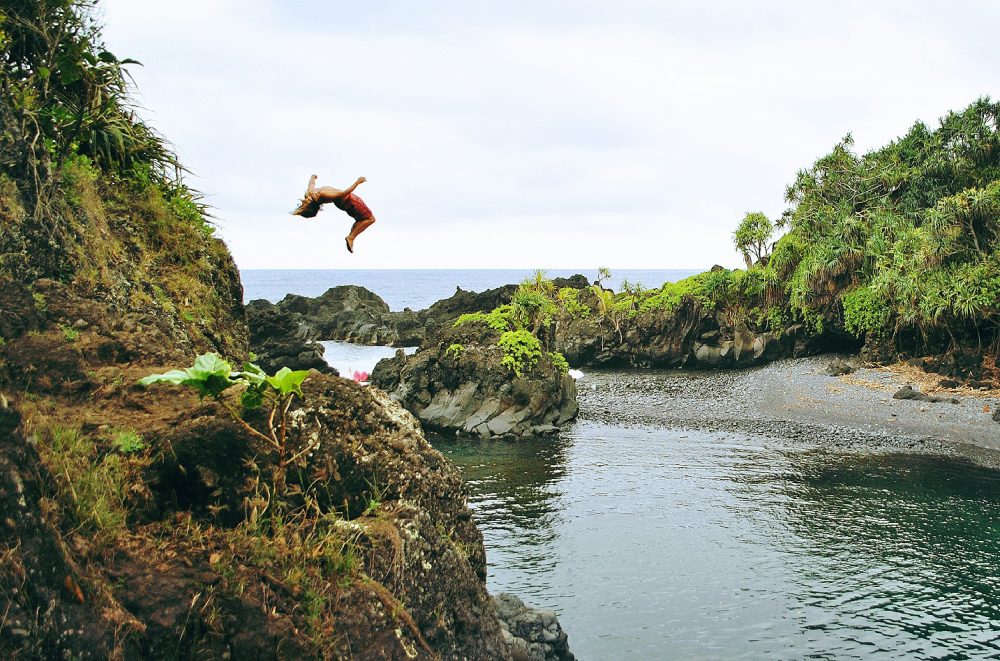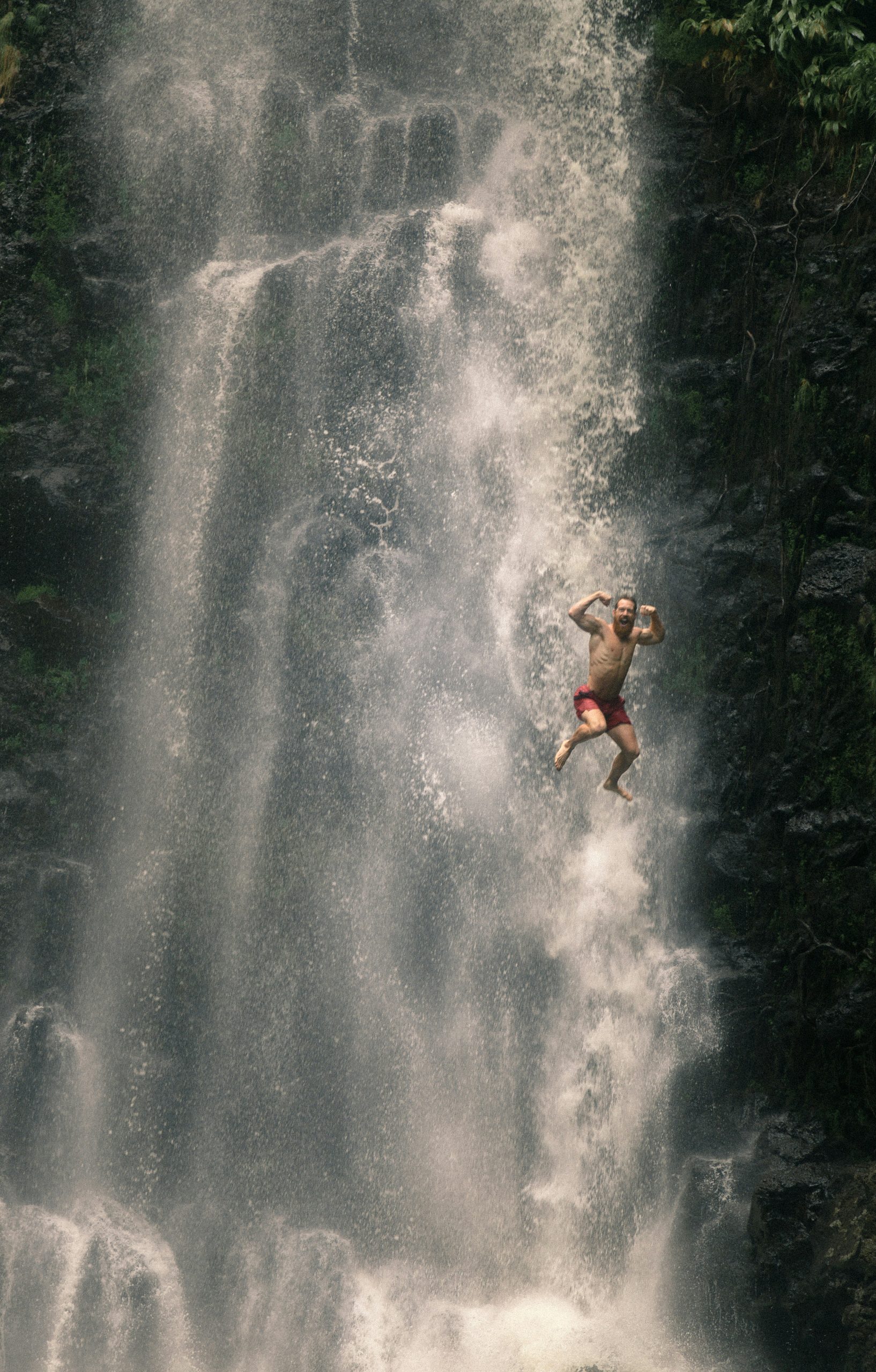Yes, cliff jumping is a sport, and is considered one of the most dangerous. In essence, cliff jumpers enjoy the raw thrill of conquering their fears while free-falling. They launch themselves off Mother Nature’s diving boards – i.e. cliffs, waterfalls, trees, and even buildings or towers. Its history spans cultures and time periods, unifying adrenaline seekers by their passion for feeling alive. Freestyle cliff jumping (aka cliff diving) is swiftly becoming known for its competitive edge. Incredibly, its origins trace back to ancient traditions and spiritual practices. The cliff jumping history is not just about the evolution of a sport. It combines human endurance, mental fortitude, and literal leaps of faith.
The origins of cliff jumping are as diverse as they are ancient, painting a vivid picture of cultural significance and practices. It began as a sacred ritual in ancient civilizations, then transformed into a mind-boggling extreme sport. Cliff jumping’s history represents a shift in human perception. A shift towards nature in a unique and indestructible way. These athletes use their sport to explore untouched corners of the world, facing fear in the pursuit of sheer exhilaration. From the highest cliff jumps in history to the story of two girls who jumped off a cliff to escape cops in a moment of cinematic fame, we’re about to tell you all the in’s and out’s of this insane sport.

Credit to @pnw_cliff_jumping IG
Cliff Jumping History
Ancient Beginnings
The earliest instances of cliff jumping can be traced back to ancient civilizations. It was often associated with religious or cultural rituals. For instance, in Hawaiian culture, a form of cliff diving known as ‘Lele Kawa‘ was not just a test of courage but a spiritual act. Warriors would leap off high cliffs to prove their bravery and faith. They believed that the gods would protect them during their descent.
There is a similar story in Greek mythology. Icarus, who famously flew too close to the sun with wings made of feathers and wax, is an allegory that resonates with the essence of cliff jumping. The boldness to soar despite the risk of falling.
Cliff jumping’s transformation from a ritualistic practice to a competitive sport began in the 18th century. The first recorded competitions, like the one in Hawaii in 1770, marked a shift in perception—from a spiritual endeavor to an athletic challenge.
Evolution into a Modern Sport
Cliff jumping’s surge in popularity can be attributed to several factors that resonate with the modern thrill-seeker’s psyche. In today’s world, adventure and unique experiences are highly valued. This sport offers a blend of natural beauty and adrenaline rush. Social media has played a significant role in this rise. Instagram, specifically, has done something very unique as a social media platform by allowing users to post adrenaline related content. Small communities of unlikely friends sprouted, the commonality being the thrill of jumping off cliffs. These small groups met at different waterfalls and swimming holes, some thousands of miles from their hometown. This process grew over the years, and then Travis Sims created the Cliff Cruise.
Cliff Cruise is the first organized event for freestyle cliff jumping. Hundreds of self-taught jumpers connect on a 10 day road trip, stopping at multiple different swimming holes and hot springs. Some of the best action videographers in the world take cliff jumping to the next level by creating viral content that has reached millions of people, inspiring them to get into the sport. Suddenly, cliff diving became more accessible. It continues to grow with the biggest cliff jump meet up in the world happening this spring in the Pacific Northwest.
Why Cliff Jumping Is So Popular
As stunning videos and photos of cliff jumps from breathtaking locations go viral, a community of enthusiasts grows. Additionally, the sport’s accessibility – requiring no equipment – is available in various natural settings and makes it appealing to a broader audience. “The greatest appeal of this sport is the challenge to your comfort zone, forcing you to conquer your fears. Your experience level doesn’t matter – it’s the fact that you’re there.” Cliff jumper Theo Goff said in an interview. “The entire community is supportive and excited for you.”
The allure of challenging oneself, both physically and mentally, against the backdrop of some of nature’s most awe-inspiring landscapes, continues to draw new participants. As more people seek activities that break the monotony of daily life and offer a sense of freedom and escapism, it is understood in the community that life begins at the edge of your comfort zone. Cliff jumping stands out as a perfect embodiment of adventure and self-discovery.
The Highest Cliff Jumps in History
Among the most remarkable feats in cliff jumping is the world record set by Laso Schaller. On 4 August 2015, Schaller, a canyoner and cliff jumper born in Brazil and raised in Switzerland, achieved the highest recorded jump from a cliff. He leaped from a height of 58.5 meters (191 ft 11 in) at the Cascata del Salto in Maggia, Switzerland. Schaller’s descent from a waterfall in the Ticino region into an 8-meter-deep plunge pool stands as one of the most breathtaking feats in cliff jumping history. Although it is the highest cliff dive recorded, the legitimacy of the record is subject to debate. Laso, having been seriously injured and requiring assistance to exit the water, faced questions about whether his attempt should be considered valid.
Despite these concerns, the daring nature of his jump is undeniable. Moreover, Lazo’s lack of a 180-degree rotation or any flips means his jump does not qualify as a high dive world record. Currently, the high dive world record is held at 172 feet, achieved with a double front flip and a half twist (Rick Charles, 1983).
In organized events like the Red Bull Cliff Diving World Series, divers routinely perform jumps from heights of 27 to 28 meters (88 to 92 feet), showcasing the sport’s evolution and the athletes’ incredible skill and bravery.
Thelma and Louise: A Whimsical Nod to Cliff Jumping
The iconic movie “Thelma & Louise” from 1991 playfully captures the spirit of adventure. The now-famous scene where the titular characters, Thelma and Louise, in a whimsical twist of fate, choose to soar off a cliff in their Thunderbird, embodying the ultimate act of freedom and camaraderie. Commonly referred to as “that movie where the girls jump off a cliff to escape the cops”. This memorable moment in cinema whimsically mirrors the essence of cliff jumping – a leap into the unknown, buoyed by the thrill of adventure and the bonds of friendship.
Cliff Diving Accident Statistics
Despite the sport’s allure, cliff diving is fraught with dangers. Injury stories range from ears being ripped off, black eyes, ACL tears, being paralyzed, or even death.
It sounds ridiculous; why would anyone do this? These injuries don’t even compare to those in very famous entertainments such as football, UFC, boxing, rugby, and many more entertaining pastimes.
Cliff diving, while exhilarating, carries significant risks. Common injuries in the sport include:
- Foot and Ankle Injuries: The impact of landing can cause severe trauma to the feet and ankles.
- Neck and Cervical Spine Injuries: Incorrect body alignment during a dive can lead to serious neck and spinal injuries.
- Lower Limb Injuries: The force of hitting the water can result in injuries to the lower limbs, including fractures.
- Lower Back Injuries: The impact with water, especially from great heights, can cause lower back injuries, including muscular strains, compression fractures, and spinal damage.
Safety Tips
Key safety tips for cliff diving include:
- Conducting a proper depth check; ensuring the landing area is at least 10 feet deep and up to 17 feet for cliffs over 50 feet.
- Throwing rocks first to gauge the hang time.
- Assessing the height of the cliff so you can understand the jump better.
- Choosing the appropriate diving body position, with shoulders directly over feet.
- Avoiding pushing someone who is hesitating to jump.
- Employing a pencil dive for safer entry, but only right before impact. In freefall, you want your arms and knees bent for control.
- Never increasing the height by more than 10 feet compared to your last jump.
- Never attempting a flip unless you can visualize the entire maneuver.
- Landing with all your muscles flexed, like a bullet.
Understanding that if you cliff jump long enough, you will get injured, but this risk can be mitigated. The fact that so many people are injured for weeks at a time and still return to the cliff is a testament to the value they receive from the adrenaline rush.

Credit to Drew Farwell
The history of cliff jumping is a test of the human spirit. Those craving adventure and joy challenge themselves against the forces of nature. From its ancient origins to the record-setting dives of athletes like Laso Schaller, cliff jumping continues to fascinate and inspire. As we embrace this thrilling sport, let’s not forget the importance of safety. Let’s secure the legacy of cliff jumping for generations to come, and fill it with stories of daring jumps and safe landings.
Discover more on sports and lifestyle here!








